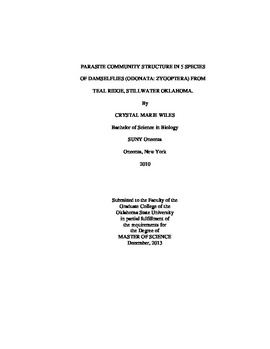| dc.contributor.advisor | Bolek, Matthew | |
| dc.contributor.author | Wiles, Crystal Marie | |
| dc.date.accessioned | 2015-06-17T20:08:35Z | |
| dc.date.available | 2015-06-17T20:08:35Z | |
| dc.date.issued | 2013-12-01 | |
| dc.identifier.uri | https://hdl.handle.net/11244/15185 | |
| dc.description.abstract | Few ecological studies exist on parasite community structure in insects and compared to other invertebrate and vertebrate groups, insects have been largely ignored in studies on parasite community structure. This is surprising because some insects, such as odonates, have become model systems for studies on host parasite interactions, and there is a desperate need for descriptive studies on their parasite community structure. In this study I examined 530 individual damselflies of five species (Argia apicalis, Enallagma civile, Ischnura hastata, Ischnura verticalis, and Lestes disjunctus australis) for their parasites and report parasite community structure parameters for these hosts. All damselflies were collected from Teal Ridge a semi-permanent wetland located in Stillwater, Oklahoma during the summer and fall of 2010-2012. I report the first record of juvenile Serpinema cf. trispinosum nematodes, along with new host records and geographical distribution information for gregarine parasites from Oklahoma damselflies. The parasite compound community of this odonate assemblage consisted of a total of 549 individual parasites, comprised of seven taxa including; five species of gregarines, two species of helminths, and one species of mite. None of the individual parasite species were host specific to a single damselfly species and all parasite species infected at least two species of damselflies. Average parasite species richness was low among the four species of damselflies ranging from a low of 0.2 + 0.4 (0-2) for I. hastata to a high of 0.3 + 0.6 (0-2) for E. civile. There was no relationship in damselfly size and parasite abundance, intensity, or species richness among any of the damselfly species examined. This study indicates that the parasite community structure of damselflies was most similar to Mariluan, 2012 study on the parasite communities of benthic aquatic insects and drastically differed in terms of standard measures of parasite community structure in vertebrate hosts which are much higher in terms of parasite prevalence, mean abundance, mean intensity and species richness. | |
| dc.format | application/pdf | |
| dc.language | en_US | |
| dc.publisher | Oklahoma State University | |
| dc.rights | Copyright is held by the author who has granted the Oklahoma State University Library the non-exclusive right to share this material in its institutional repository. Contact Digital Library Services at lib-dls@okstate.edu or 405-744-9161 for the permission policy on the use, reproduction or distribution of this material. | |
| dc.title | Parasite Community Structure in 5 Species of Damselflies (Odonata: Zygoptera) from Teal Ridge, Stillwater Oklahoma. | |
| dc.type | text | |
| dc.contributor.committeeMember | Papes, Monica | |
| dc.contributor.committeeMember | Reichard, Mason | |
| osu.filename | Wiles_okstate_0664M_13014.pdf | |
| osu.accesstype | Open Access | |
| dc.description.department | Zoology | |
| dc.type.genre | Thesis | |
| dc.subject.keywords | community | |
| dc.subject.keywords | damselfly | |
| dc.subject.keywords | gregarine | |
| dc.subject.keywords | nematode | |
| dc.subject.keywords | oklahoma | |
| dc.subject.keywords | trematode | |
